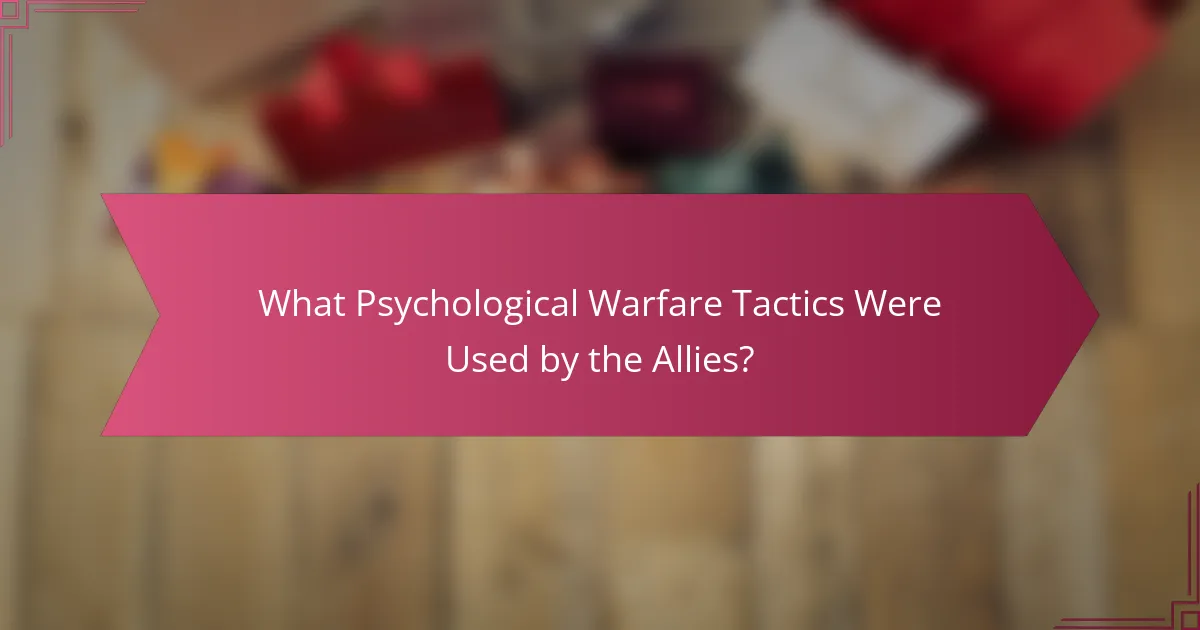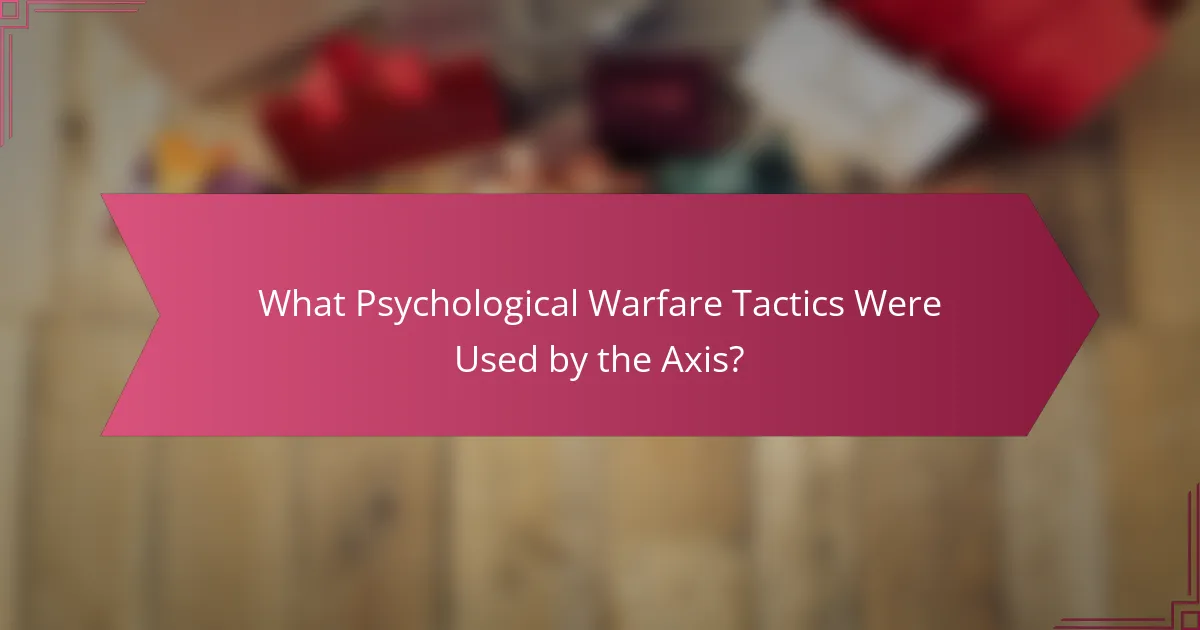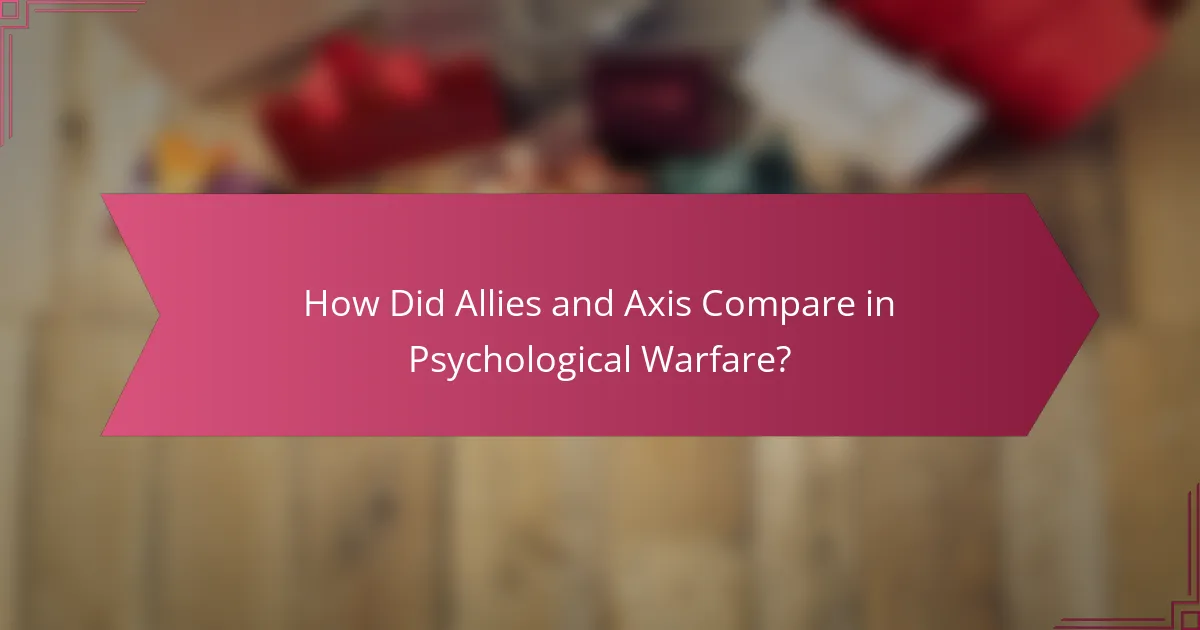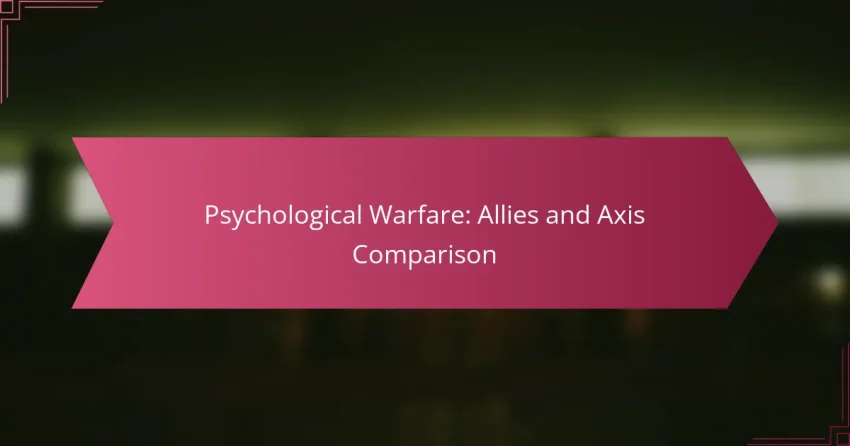During World War II, both the Allies and Axis powers utilized psychological warfare as a critical component of their military strategies. The Allies focused on propaganda and deception to weaken enemy morale, while the Axis employed fear and disinformation to manipulate public perception. Each side’s tactics aimed to destabilize the opposition and strengthen their own positions, showcasing the profound impact of psychological operations on the war’s outcome.

What Psychological Warfare Tactics Were Used by the Allies?
The Allies employed various psychological warfare tactics to undermine enemy morale and influence public perception during World War II. These tactics included propaganda campaigns, deception operations, and psychological operations (PSYOP), each designed to manipulate information and create confusion among Axis forces.
Propaganda campaigns
Propaganda campaigns were a cornerstone of Allied psychological warfare, aiming to shape public opinion and boost morale. The Allies used posters, films, and radio broadcasts to convey messages that highlighted the strength and righteousness of their cause while portraying the Axis powers negatively.
For example, the British Ministry of Information produced posters that encouraged enlistment and depicted the enemy as brutal and oppressive. These campaigns often included slogans that resonated with national pride and unity, effectively rallying support for the war effort.
Deception operations
Deception operations involved misleading the enemy about Allied intentions and capabilities. The Allies executed various strategies, such as creating fake military installations and using dummy equipment to misdirect Axis forces.
One notable operation was Operation Fortitude, which aimed to convince the Germans that the invasion of France would occur at Pas de Calais rather than Normandy. This operation involved a combination of fake radio transmissions and the deployment of inflatable tanks, successfully diverting German resources and attention.
Psychological operations (PSYOP)
Psychological operations (PSYOP) focused on directly influencing enemy troops and civilians through targeted messaging. The Allies disseminated leaflets and broadcasts that aimed to demoralize enemy soldiers and encourage defection.
For instance, leaflets dropped over German lines often contained messages that highlighted the futility of resistance and the benefits of surrender. Such tactics were designed to weaken the resolve of enemy combatants and create dissent within the ranks, ultimately contributing to the Allies’ strategic objectives.

What Psychological Warfare Tactics Were Used by the Axis?
The Axis powers employed various psychological warfare tactics to undermine their enemies and manipulate public perception. These strategies included fear and intimidation, disinformation, and targeting civilian morale, all aimed at destabilizing opposition and maintaining control.
Fear and intimidation
The Axis utilized fear and intimidation as a primary tactic to control populations and suppress dissent. This often involved brutal reprisals against civilians or the threat of violence to instill a sense of helplessness among the enemy. For example, the bombing campaigns over cities aimed not just at military targets but also at creating widespread panic.
By showcasing their military might and willingness to use it, the Axis powers sought to deter resistance and encourage compliance among both enemy soldiers and civilian populations. The psychological impact of such tactics often led to a chilling effect on opposition movements.
Disinformation strategies
Disinformation was a key component of the Axis psychological warfare, used to mislead and confuse enemy forces. This included spreading false information about troop movements, military capabilities, and even fabricated news to manipulate public opinion. For instance, propaganda broadcasts were designed to create doubt about the Allies’ strength and resolve.
Effective disinformation campaigns relied on the strategic use of media, including radio and printed materials, to reach a broad audience. The goal was to create a narrative that favored the Axis, thereby weakening the enemy’s morale and unity.
Targeting civilian morale
The Axis powers recognized that civilian morale was crucial to the war effort, and they sought to undermine it through various means. This included targeted bombings of civilian infrastructure and psychological operations designed to create despair and hopelessness among the populace. By disrupting daily life and instilling fear, they aimed to erode support for the war among citizens.
Additionally, propaganda was used to convey messages of defeat and hopelessness, further demoralizing the civilian population. The intent was to make civilians feel that resistance was futile, thereby encouraging them to accept Axis control or even collaborate with occupying forces.

How Did Allies and Axis Compare in Psychological Warfare?
The Allies and Axis powers employed distinct psychological warfare strategies during World War II, each aiming to demoralize the enemy and bolster their own support. The effectiveness of these tactics varied based on their execution, target audiences, and overall historical impact.
Tactics effectiveness
The Allies primarily focused on propaganda that highlighted Axis atrocities while promoting their own values of freedom and democracy. This approach aimed to unite the home front and encourage enlistment, often proving effective in rallying public support.
In contrast, the Axis powers utilized fear and intimidation, often resorting to threats and violence to suppress dissent. While this tactic instilled immediate compliance, it often backfired by fostering resentment and resistance among occupied populations.
Target audiences
The Allies targeted both enemy combatants and civilian populations, aiming to undermine morale and encourage defection. Their messages were crafted to resonate with shared values and aspirations, appealing to a sense of justice and hope.
The Axis, on the other hand, focused heavily on their own citizens and occupied territories, attempting to instill a sense of superiority and loyalty through aggressive nationalism. Their messaging often emphasized the supposed threat posed by the Allies, aiming to unify their base through fear.
Historical impact
The psychological warfare tactics of the Allies contributed significantly to their eventual victory, as they successfully swayed public opinion and maintained morale throughout the war. This approach helped to create a strong coalition of nations committed to defeating the Axis powers.
Conversely, the Axis powers’ reliance on oppressive tactics ultimately led to widespread disillusionment and resistance, undermining their control over occupied regions. The long-term effects of these strategies can still be seen in the historical narratives and national identities shaped by the war’s outcome.

What Are the Key Psychological Warfare Outcomes?
Key psychological warfare outcomes include shifts in public perception, modifications in military tactics, and lasting impacts on society. These outcomes can significantly influence the course of conflicts and the stability of nations involved.
Influence on public opinion
Psychological warfare aims to manipulate public opinion to support or undermine a cause. Techniques such as propaganda, misinformation, and fear tactics can sway civilian attitudes, often leading to increased support for military actions or decreased morale among enemy populations.
For instance, during World War II, both the Allies and Axis powers utilized propaganda to promote their ideologies and demonize the opposition. This manipulation of public sentiment can create a narrative that justifies military actions and fosters national unity.
Military strategy adjustments
Psychological warfare can lead to significant adjustments in military strategies. By understanding the psychological state of both their own troops and the enemy, military leaders can devise plans that exploit weaknesses or bolster morale.
For example, the use of misinformation can lead an adversary to misallocate resources or misjudge the timing of attacks. This strategic manipulation can create opportunities for decisive victories while minimizing casualties.
Long-term societal effects
The long-term effects of psychological warfare can reshape societies well beyond the immediate conflict. Nations may experience shifts in cultural identity, political structures, and social cohesion as a result of sustained psychological operations.
In the aftermath of conflicts, societies may grapple with trauma, mistrust, and divisions that stem from psychological tactics used during war. Understanding these effects is crucial for post-conflict reconciliation and rebuilding efforts.

What Frameworks Help Analyze Psychological Warfare?
Frameworks for analyzing psychological warfare provide structured approaches to understanding the strategies and impacts of psychological operations. These frameworks help in dissecting the methods used by both Allies and Axis powers, allowing for a clearer comparison of their tactics and effectiveness.
Psychological operations models
Psychological operations models focus on the systematic planning and execution of campaigns aimed at influencing the perceptions and behaviors of target audiences. These models often include stages such as assessment, strategy development, execution, and evaluation. For instance, the U.S. military employs the Joint Psychological Operations Planning Process, which emphasizes understanding the audience and tailoring messages accordingly.
Key considerations in these models include the cultural context of the target audience, the medium of communication, and the timing of the message. Effective psychological operations can lead to significant shifts in public opinion or morale, making it crucial to align operations with broader strategic objectives.
Comparative analysis frameworks
Comparative analysis frameworks allow for the evaluation of psychological warfare tactics across different nations or historical contexts. These frameworks often utilize criteria such as effectiveness, reach, and adaptability to assess various psychological operations. For example, one might compare the propaganda techniques used by Nazi Germany with those employed by the Allies during World War II, focusing on their messaging strategies and audience engagement.
When employing comparative analysis, it is essential to consider the socio-political environment and technological capabilities of the time. A structured approach, such as a SWOT analysis (Strengths, Weaknesses, Opportunities, Threats), can help in identifying the relative advantages and disadvantages of each side’s psychological tactics.

What Are Emerging Trends in Psychological Warfare?
Emerging trends in psychological warfare focus on leveraging technology and social media to influence perceptions and behaviors. This includes the use of digital platforms to disseminate disinformation, manipulate narratives, and create psychological effects on target populations.
Digital warfare tactics
Digital warfare tactics involve using online tools and platforms to conduct psychological operations. These tactics can include social media campaigns, targeted ads, and the dissemination of fake news to shape public opinion and sow discord among adversaries.
One common approach is the use of bots and automated accounts to amplify specific messages or disinformation. This can create the illusion of widespread support or dissent, influencing real-world behaviors and opinions. For instance, during elections, such tactics can sway voter sentiment by promoting divisive narratives.
To effectively counter digital warfare tactics, organizations should monitor online discourse and engage in proactive communication strategies. Establishing a clear and consistent messaging framework can help mitigate the impact of misinformation and maintain public trust. Regularly updating stakeholders on developments can also reduce vulnerability to psychological manipulation.
